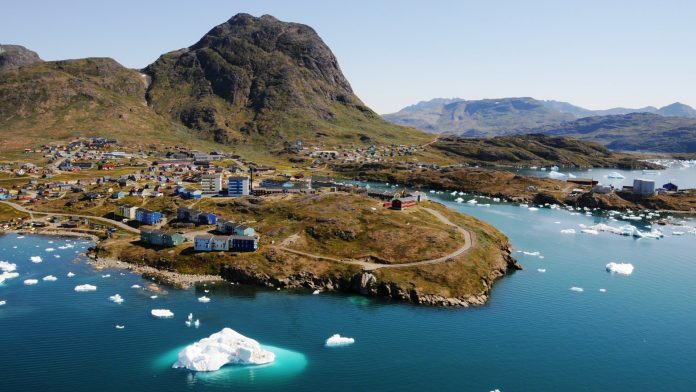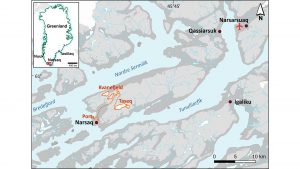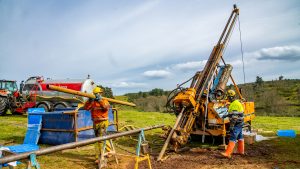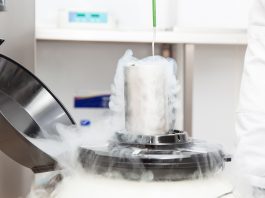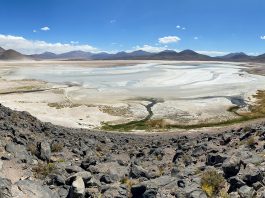Energy Transition Minerals Ltd’s aim is to develop mineral projects to meet the growing need for critical minerals.
Energy Transition Minerals Ltd (formerly Greenland Minerals Limited) is an ASX-listed company, ASX:ETM. The company’s aim is to develop mineral projects to meet the growing need for critical materials vital to global decarbonisation and the accelerating transition to renewable energy systems.
The company’s two current mineral projects, the Kvanefjeld rare earth project in southern Greenland and the Villasrubias lithium project in Spain, are aimed at meeting this increasing demand.
The company has focused on the development of the 100%-owned Kvanefjeld project since 2007. Kvanefjeld is one of the world’s largest and most important undeveloped projects with the potential to be a significant world-class supplier of rare earths, in particular the group of ‘magnet metals’ (neodymium, praseodymium, terbium and dysprosium) which hold the key to an energy-efficient and environmentally sustainable future.
The Kvanefjeld project has an established (JORC 2012 compliant) mineral resource of more than one billion tonnes, within which is an ore reserve of 108 million tonnes, sufficient to sustain a 37-year mine life. The size of the resource and the rate of conversion of resources into reserves suggests that the project could operate for significantly longer than the initially planned 37 years.
Kvanefjeld offers a new, simpler path to rare earth production – conventional mineral flotation followed by an atmospheric leach and solvent extraction. The high temperatures and pressures required to treat the more common refractory ores are not required. This mineral project also has the benefit of producing saleable by-products, which will contribute to low production costs.
Kvanefjeld provides an excellent opportunity to develop a large, stable source of rare earths that customers can rely on for long-term secure supply that will be independent of the traditional supply chain. The project, if developed, has the potential to deliver significant economic and social dividends to Greenland and its people and underpin the country’s desire to achieve full independence from Denmark.
The Kvanefjeld mineral project: History and status
The company has invested more than A$130m in accordance with Greenland’s legislation and guidelines, creating a ‘development ready’ mineral project. The company has devoted significant resources to working with local communities and the government to ensure that the views of all stakeholders have been appropriately considered during the process of planning and development.
The Kvanefjeld project is located on the northern Ilimaussaq Intrusive Complex in southern Greenland – a unique geological formation. After drilling over 60,000m of diamond core, the company has identified three mineral resources – Kvanefjeld, Sørensen, and Zone 3.
The company’s development activities have focused on the Kvanefjeld resource.
While it is clear the size of the mineral resource is globally significant, the project has a key advantage in the amenability of the host minerals to acid leaching at atmospheric pressure. The characteristics of the host minerals allow for efficient beneficiation, including the recovery of a saleable zinc concentrate, followed by a conventional acid leach at atmospheric pressure and solvent extraction to achieve high rare earth recoveries.
By way of contrast, rare earths are more commonly hosted in refractory minerals, which require the application of temperature and/or pressure (a process generally referred to as ‘cracking’) to liberate the rare earths. Cracking adds cost and technical complexity to any flowsheet.
In the original project flowsheet, a small quantity of uranium is removed from the leach solution by solvent extraction, at which point it can either be precipitated into a saleable uranium concentrate product, or it can remain in solution and be deposited in the tailings storage facility as waste.
This mineral project will additionally produce a zinc concentrate and fluorspar from the process water treatment plant. Fluorspar and zinc have ready markets globally.
Optimisation test work completed in 2019, in co-operation with Shenghe Resources Holding Co Ltd, improved the rare earth recoveries, increasing the projected output of commercially important rare earths to:
- Neodymium oxide 4,260 tpa
- Praseodymium oxide 1,420 tpa
- Dysprosium oxide 270 tpa
- Terbium oxide 45 tpa
Average annual by-product output includes:
- Uranium oxide 451 tpa
- Zinc concentrate 6,060 tpa
- Fluorspar 12,417 tpa
The project area is located adjacent to deep-water fjords that allow for easy shipping access all year round. An international airport is located 35km away, and a nearby lake system has been identified as a potential site for the future development of a facility to generate hydroelectric power.
The company completed a feasibility study of the Kvanefjeld mineral project in 2015. Further optimisation studies were completed in 2016 and 2019. Those studies incorporated design and flowsheet improvements that had the effect of significantly reducing the capital and unit costs of the project. The company believes that, after by-product credits, the project will be one of the, if not the, lowest cost producer of rare earth oxide equivalents.
The 2015 feasibility study, the project’s Environmental Impact Assessment (EIA), Social Impact Assessment (SIA) and a Marine Safety Study are the basis of the company’s application for a license to develop the project (an Exploitation License). The company submitted the first drafts of an EIA and SIA at the end of 2015 for review by the government. Over the next five years, the assessments were subjected to extensive review by the government and their independent advisors.
The EIA, together with all of the supporting expert reports, has been assessed by the Danish Centre for the Environment (DCE) and by Greenland’s Institute of Natural Resources (GINR) in an extensive formal examination and review process, as mandated by Greenland legislation. The DCE and GINR concluded that the Kvanefjeld mineral project is ‘very likely to be carried out without more extensive environmental effects than described’, provided that the best available technology and best environmental practice are used.
By the end of 2020, the Marine Safety Study, SIA, and EIA had been approved for release for public consultation in accordance with the applicable legislation. The company’s feasibility study was accepted by the government, during the same period, as having demonstrated the economic viability of the project.
The formal public consultation period commenced in December 2020 and ultimately ran until September 2021. The legal requirement for mineral projects and others is a minimum consultation period of eight weeks and 36 weeks is unprecedented. Relevant to the length of the consultation period was the calling of a snap election, which occurred in April 2021. The election resulted in a change in the coalition of parties comprising the government. The major party in the new coalition was the Inuit Ataqatigiit (IA) party which had campaigned on an anti-uranium platform.
The purpose of public consultation is to provide any stakeholder with the opportunity to ask questions, make comments and make submissions regarding the mineral project’s potential impacts. The company and the government are obliged to respond to all issues raised during public consultation and to compile these responses into a ‘White Paper’ – one for each impact assessment.
The company completed its contribution to both White Papers in October 2022. The DCE and GINR completed a review of the environmental impact White Paper and concluded that all major environmental issues raised during public consultation had been adequately described in the summary EIA and/or in the background studies. The newly-elected Government of Greenland declined to prepare responses for the White Book for the social impact assessment and declined to review the company’s EIA responses.
The preparation of the White Paper is one of the last statutory requirements to be completed prior to the issue of an Exploitation License.
Commencement of arbitration
In November 2021, Greenland’s parliament passed Act No. 20, which bans the prospecting, exploration, and exploitation of mineral deposits where the concentration of uranium is above 100 ppm. The average uranium grade in the ore reserve at Kvanefjeld is approximately 360 ppm.
In meetings following the passing of Act No. 20, representatives of the government indicated that Act No. 20 would prevent the Kvanefjeld project from proceeding. This would be the case even though the company was satisfied that its mineral projects had complied with the statutory requirements set out in the relevant legislation and the company’s exploration license.
Efforts to establish a constructive dialogue with the Greenland authorities were unsuccessful, and the company was left with no other option than to request the dispute be resolved by arbitration. Arbitration in Copenhagen under Danish law is the dispute resolution mechanism contained in the Kvanefjeld Exploration License.
Subsequent Exploitation License application
In December 2022, the company submitted an alternative application for an Exploitation License to the government. The alternative proposes a development scenario where the company will treat uranium as an impurity and manage it as waste material.
Uranium is a contaminant for rare earth intermediate products of the type that the project is proposing to produce, and it is, therefore, necessary to remove the uranium to ensure a clean product is delivered to customers. The original Exploitation License application contemplated removing the uranium and subsequently precipitating a uranium oxide for sale.
Under the alternative development scenario, the uranium will be removed from the rare earth intermediate but will not be precipitated and will remain as part of the tailings stream to be safely stored in the project’s tailings storage facility.
The alternative development scenario did not require significant amendments to either the mineral project’s environmental or social impact assessments, already the subject of extensive scrutiny. Arcadis, an internationally regarded consultancy in the field of radiological assessment, confirmed that the alternative management of uranium as a waste will not materially change the overall radiological impact of the project.
A revised feasibility study was submitted with the new Exploitation License application, incorporating the conversion of uranium from a saleable product to a waste component of the tailings stream. The study shows that the change will not impact the commercial viability of the project.
The amended Exploitation Licence application does not replace the existing application but is an alternative development proposal to the existing application.
The Villasrubias mineral project
On 14 July 2022, the company announced that it has entered into a binding head of agreement with Technology Metals Europe SL (‘TME SL’) and its sole shareholder Welsbach Holdings Pte Ltd, for the right to earn-in a 51% interest in TME SL. TME SL is the sole owner of an exploration permit in Spain prospective for lithium, known as the Villasrubias mineral project.
Villasrubias is a historic aplite and pegmatite mining district, known for the production of tin alongside feldspar and quartz. Mapping and sampling by the company and work carried out previously by the Sociedad de Investigacion y Explotacion Minera de Castilla Y Leon, an entity sponsored by the regional government of Castilla y Leon, has identified lithium minerals associated with pegmatites at the surface, alongside elevated lithium, tin, niobium, and tantalum.
The company can earn its interest in TME SL by spending AU$3,000,000 on a jointly agreed work programme in relation to the tenement within three years. The three-year period commenced on 28 October 2022, when the company obtained shareholder approval for the transaction.
Following a visit to the site of the mineral project by senior management in November 2022, an initial work programme and budget was agreed on. The initial work programme will build on previous mineral exploration and mining data, with the aim of identifying the first phase of drill targets.
Exploration activity at the Villasrubias mineral project started in December 2022, including a drone aeromagnetic and electromagnetic survey, and a very low-frequency electromagnetic tomography survey, along with geological mapping, sampling, and trenching to identify the extension of pegmatite bodies. The results of the exploration will be shared as they come available.
The survey identified several areas of interest for a drill campaign that commenced in March 2023. The maiden 1,500m, ten-hole drilling campaign is aimed at testing the targets that were identified during soil sampling and the drone survey. Initial drill cores have been sent for assaying, and results are expected in late April or early May.
A follow-up second drill programme is being scheduled for the second half of 2023, with planning to be based on the results of the maiden programme.
In closing
As of 31 December 2022, it had a cash balance of $25m. The company remains committed to the development of the Kvanefjeld mineral project and looks forward to working with the government of Greenland on viable development paths. The company will continue to work with Greenland communities to address any concerns and develop the Kvanefjeld project in a manner that will minimise environmental impacts and provide benefits to Greenland for decades ahead.
Exploration and evaluation work on the Villasrubias lithium project will continue following the high-impact drilling programme that commenced in March 2023.
The company has been actively reviewing opportunities to acquire new technology metals projects, with the view of increasing the company’s portfolio of mineral projects, provided it creates shareholder value.
Please note, this article will also appear in the fourteenth edition of our quarterly publication.

